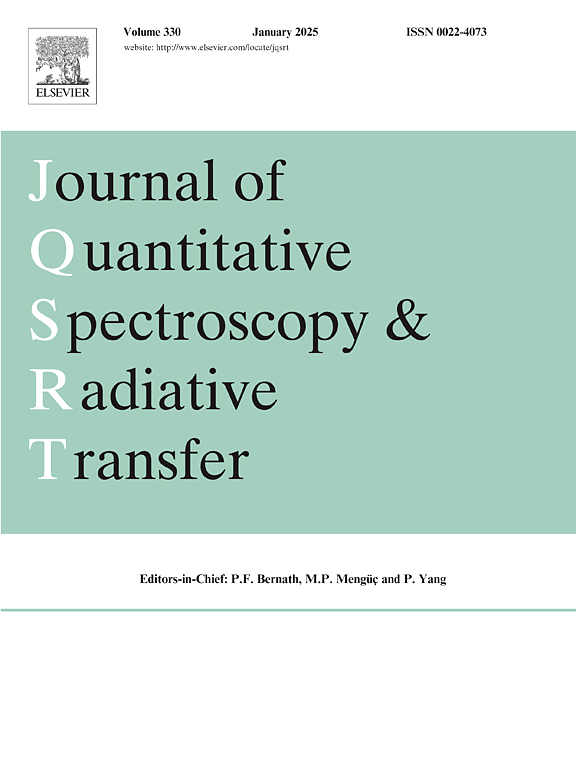Development and demonstration of a two-color nitric oxide vibrational temperature diagnostic using spectrally-resolved ultraviolet laser absorption
IF 2.3
3区 物理与天体物理
Q2 OPTICS
Journal of Quantitative Spectroscopy & Radiative Transfer
Pub Date : 2024-11-21
DOI:10.1016/j.jqsrt.2024.109275
引用次数: 0
Abstract
Development of a new ultraviolet (UV) laser absorption diagnostic has enabled the probing of nitric oxide (NO) in the second excited vibrational state (v” = 2) for inferences of quantum-state-specific number density and vibrational temperature time-histories. Spectroscopic modeling informed the selection of the new 246.3222 nm wavelength, as this wavelength exhibits high sensitivity for thermometry in the 2000 – 8000 K temperature range. This 246.3222 nm absorption feature consists of contributions from the , , , and transitions all originating in the v” = 2 state. Absorption cross-sections at this selected wavelength were measured in reflected shock experiments for sweeps of both wavelength and temperature. The wavelength sweep investigated cross-sections over a 246.3202 – 246.3246 nm range at 4590 K, and the temperature sweep measured cross-sections over a 2500 – 7500 K range at the peak of the absorption feature (246.3222 nm). Cross-section results agree with the Stanford NO gamma-band model to within 5%, confirming the use of the model for subsequent thermometry studies. Thermometry was demonstrated in reflected shock experiments probing the vibrational relaxation and chemical reactions in 2% NO diluted in either argon (Ar) or nitrogen (N). These experiments leverage previous UV laser absorption diagnostics that probe NO in the ground vibrational state (v” = 0) using the R11(26.5), R12(34.5), Q21(26.5) , and Q22(34.5) transitions near 224.8155 nm and the Q11(12.5) , R12(19.5) , P21(12.5) , and Q22(19.5) transitions near 226.1026 nm, which were studied in Ref. [1]. The combination of the new diagnostic wavelength with previously validated diagnostics yields low-uncertainty vibrational temperature time-histories that are in excellent agreement with previously inferred vibrational relaxation time results from Refs. [2] and [3]. Future work will apply this two-color nitric oxide vibrational temperature diagnostic to probe the vibrational temperature of NO formed in high-temperature, shock-heated air at conditions relevant to hypersonic and reentry vehicles.
光谱分辨紫外激光吸收双色一氧化氮振动温度诊断仪的研制与演示
一种新的紫外(UV)激光吸收诊断技术的发展,使探测一氧化氮(NO)在第二激发振动态(v ' = 2)的推断量子态特定数密度和振动温度时程成为可能。光谱建模为新的246.3222 nm波长的选择提供了信息,因为该波长在2000 - 8000 K温度范围内具有高灵敏度。这个246.3222 nm的吸收特征由R12(24.5)、R11(15.5)、Q22(24.5)和Q21(15.5)的跃迁组成,它们都起源于v ' = 2态。在波长和温度扫描的反射冲击实验中测量了该选定波长的吸收截面。波长扫描在4590 K下测量了246.3202 ~ 246.3246 nm范围内的截面,温度扫描在2500 ~ 7500 K范围内测量了吸收特征峰(246.3222 nm)的截面。横截面结果与斯坦福大学NO伽玛带模型一致,误差在±5%以内,证实了该模型可用于后续的测温研究。在2% NO稀释于氩气(Ar)或氮气(N2)中的反射冲击实验中,采用了测温法探测振动弛豫和化学反应。这些实验利用了先前的紫外激光吸收诊断,利用R11(26.5)、R12(34.5)、Q21(26.5)和Q22(34.5)在224.8155 nm附近的跃迁和Q11(12.5)、R12(19.5)、P21(12.5)和Q22(19.5)在226.1026 nm附近的跃迁探测NO在地面振动状态(v ' = 0)。新的诊断波长与先前验证的诊断相结合,产生了低不确定性的振动温度时程,与先前从Refs推断的振动松弛时间结果非常吻合。[2]和[3]。未来的工作将应用这种双色一氧化氮振动温度诊断来探测与高超声速和再入飞行器相关的高温、冲击加热空气中形成的一氧化氮的振动温度。
本文章由计算机程序翻译,如有差异,请以英文原文为准。
求助全文
约1分钟内获得全文
求助全文
来源期刊
CiteScore
5.30
自引率
21.70%
发文量
273
审稿时长
58 days
期刊介绍:
Papers with the following subject areas are suitable for publication in the Journal of Quantitative Spectroscopy and Radiative Transfer:
- Theoretical and experimental aspects of the spectra of atoms, molecules, ions, and plasmas.
- Spectral lineshape studies including models and computational algorithms.
- Atmospheric spectroscopy.
- Theoretical and experimental aspects of light scattering.
- Application of light scattering in particle characterization and remote sensing.
- Application of light scattering in biological sciences and medicine.
- Radiative transfer in absorbing, emitting, and scattering media.
- Radiative transfer in stochastic media.

 求助内容:
求助内容: 应助结果提醒方式:
应助结果提醒方式:


